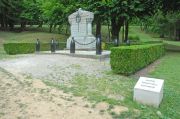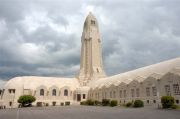 |
 |
Verdun, in the hell of the Great War |
 |
The WW1 longest battle took place around Verdun in the Meuse department. Scattered around a thick forest, numerous remains bear witness of the fierce fighting.
[ Practical ]
Getting there
- By road
260 km from Paris on autoroute A4 till 30 then on D163 till Verdun
- By train
TGV from Paris Gare de l’Est to Meuse TGV then bus to Verdun. The journey takes 1 h 40 mn.
Lodging
Les Jardins du Mess
Hôtel de Montaulbain
Hôtel Orchidées
Hôtel du Tigre
Le Privilège
Restaurants
La Péniche
Auberge de la Tour
Anna Maria
L’Abri des Pèlerins
Hôtel Orchidées
« Des Flammes à la Lumière »
Show at the end of June and in July
Admission : €20 to €28 / €12 to €18
Tel : 0329845000
www.spectacle-verdun.com
ONF guided tours
Price : €5
www.lesforetsdelhistoire14-18.fr
Information
- Lorraine Tourist Office
Tel : 0383800180
www.tourisme-lorraine.fr
- Meuse Tourist Office
Tel : 0329457840
www.tourisme-meuse.com
- Verdun Tourist Office
Tel : 0329861418
www.tourisme-verdun.fr
Verdun. For many people, particularly in France and Germany, this name is synonymous with World War One. It is indeed around this city of Eastern France that took place the longest and one of the bloodiest battles of the conflict. The casualty figures speak for themselves. From 21 February to 18 December 1916, 302 days of fierce fighting and heavy shelling resulted in 306,000 dead or missing and 400,000 wounded.
 Buried under the vegetation Buried under the vegetation
Nowadays, it is difficult to get an idea what the area looked like at the time because after the war 10,000 ha of softwoods and hardwoods were planted on the Red Zone, the heart of the battlefield. Why? .. To preserve the place and make it a site of remembrance, but also for security reasons and to prevent people from walking or returning to settle on lands that were full of unexploded ordnance. On the first day only, the Germans fired a million shells over a 20 km wide and 4 km deep area and 60 million were fired during the entire battle. But historians estimate that 25% have not exploded. Even now, a century later, forest rangers still find hundreds of them every year !!!
Some vestiges of the battle are now buried under the vegetation, much like the Mayan pyramids in the Mexican jungle.
 Impressive ruins Impressive ruins
This is the case of Fort Souville, the only structure of the French system of fortifications that resisted the Germans during their final attempt to take Verdun in July 1916. Footpaths allow you to go there quite easily by yourself. However, it is much more interesting to discover it through the guided tours organized every month by the ONF (National Forests Office). Along the way, the guide shows indeed other fortifications, machine gun nests, bunkers, remnants of trenches and explains where was the front line, where attacks and reinforcements came from and so on. He also knows the most spectacular parts of the fort whose ruins are impressive although it was badly damaged by bombing and its walls have suffered dislocation from tree roots. So it is forbidden and dangerous to go inside.
 Vaux and Douaumont forts Vaux and Douaumont forts
If you want to see how looked like the interior of a fort, two are open to the public. The Fort de Vaux and the Fort de Douaumont who both were quickly captured by the Germans who, then, occupied them for several months. The first has some rooms furnished as they were at the time to give an idea of the living conditions of the defenders. It is the only one where fighting took place inside. The French garrison resisted to the Germans for 7 days and only surrendered because water and ammunition were exhausted. A bigger structure, Fort Douaumont retains some gun turrets of which one is visible from the inside. He was taken by surprise, without a fight, but while it was in German hands artillery fire caused the explosion of a stock of ammunition and 900 soldiers were killed. 670 of them are still buried in a gallery that has been walled up.

 Fleury-devant-Douaumont © T.Joly Fleury-devant-Douaumont © T.Joly
|
 Lost villages Lost villages
Nearby, in the woods is the site where once stood Fleury-devant-Douaumont, one of the nine villages that have disappeared during the battle. Captured and recaptured 16 times by the Germans and French in two months, it was completely obliterated and there is nothing left to see, not even ruins. Only a few numbered blocks recall the location of the houses. The chapel visible today was built after the war in memory of the dead. As the pilgrim shelter built a little bit further in 1920 to welcome the first visitors. It is now a restaurant.
Also in the same area, in front of a military cemetery where over 16,000 soldiers are buried, stands the largest and most moving battlefield monument: the Douaumont ossuary. 137 m long, with a tower 46 meters high, it was built from 1920 to 1935 at the initiative of the Bishop of Verdun and with the financial assistance of 120 French and 26 foreign cities including Liege and Chicago.

 Douaumont ossuary © T.Joly Douaumont ossuary © T.Joly
|
 130,000 unidentified soldiers 130,000 unidentified soldiers
It contains the remains of 130,000 unidentified soldiers who lie beneath 46 granite slabs, each bearing the name of an area of the battlefield. It is possible to access the top of the tower but the view is of little interest. But do not miss the glass-plate stereoviews images on display near the gift shop. They depict fighting, soldiers and trenches.
Almost next door, the Memorial Museum is closed for renovations until the end of 2015. In the meantime, part of its collections is visible in Verdun in an exhibition entitled "What remains of the Great War? ". Evoking the battle of Verdun, but also the society at war and the impact on the world, it is hold at the World Peace Centre, which is housed in the former Bishop's Palace, a beautiful classical building built in the 18th century during the reign of Louis XV. The nearby cathedral also deserves a look.
 Pleasant town Pleasant town
Largest Romanesque building in eastern France, it was begun in 990 and refurbished in the 14th century, hence its beautiful flamboyant Gothic cloister. It's a miracle that these two monuments have survived the numerous bombings that occurred during the battle commemorated by an imposing Victory monument overlooking the Meuse and the marina. The quay area by the bank of the river is very pleasant and now constitutes the heart of the city with many bars, restaurants and a pedestrian zone where concerts are often held. There are also two monuments worth a glance. The former officers' mess whose size gives an idea of the number of military formerly living in the surroundings. The 20m high Tour Chaussée, built in the 14th century, which was once one of the three city gates.
 Underground citadel Underground citadel
In addition, under the upper town lies an underground citadel dug in the late 19th century that, during the fighting, housed up to 2,000 soldiers as well as gunpowder and munitions warehouses, a telephone exchange, a mill, a bakery and kitchen units that supplied the front. This is also where was chosen the unknown soldier resting in peace under the Arch of Triumph in Paris. A trolley tour allows you to explore a small part of the 7 km of galleries and an exhibition chronicles the soldiers daily life during the battle. Lastly, in June and July, a sound and light show tells the story of the battle. Named “From the Flames…. To the Light”, it is the largest show of its kind on First World War with 250 volunteer actors on stage, it takes place in the former quarries of Haudainville, on the outskirts of Verdun.
October 31, 2016
Thierry Joly 

|
|
 |

|
 |



